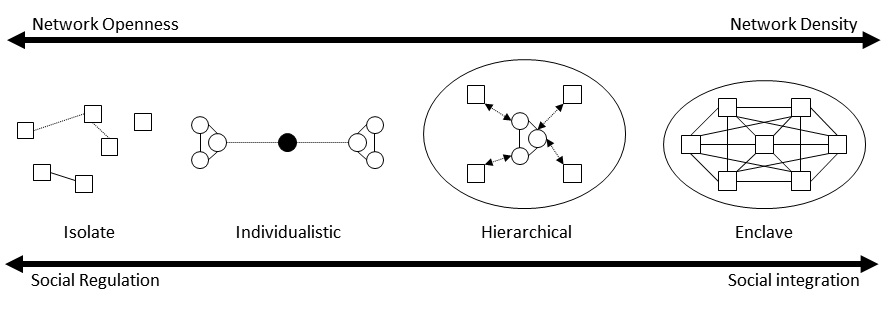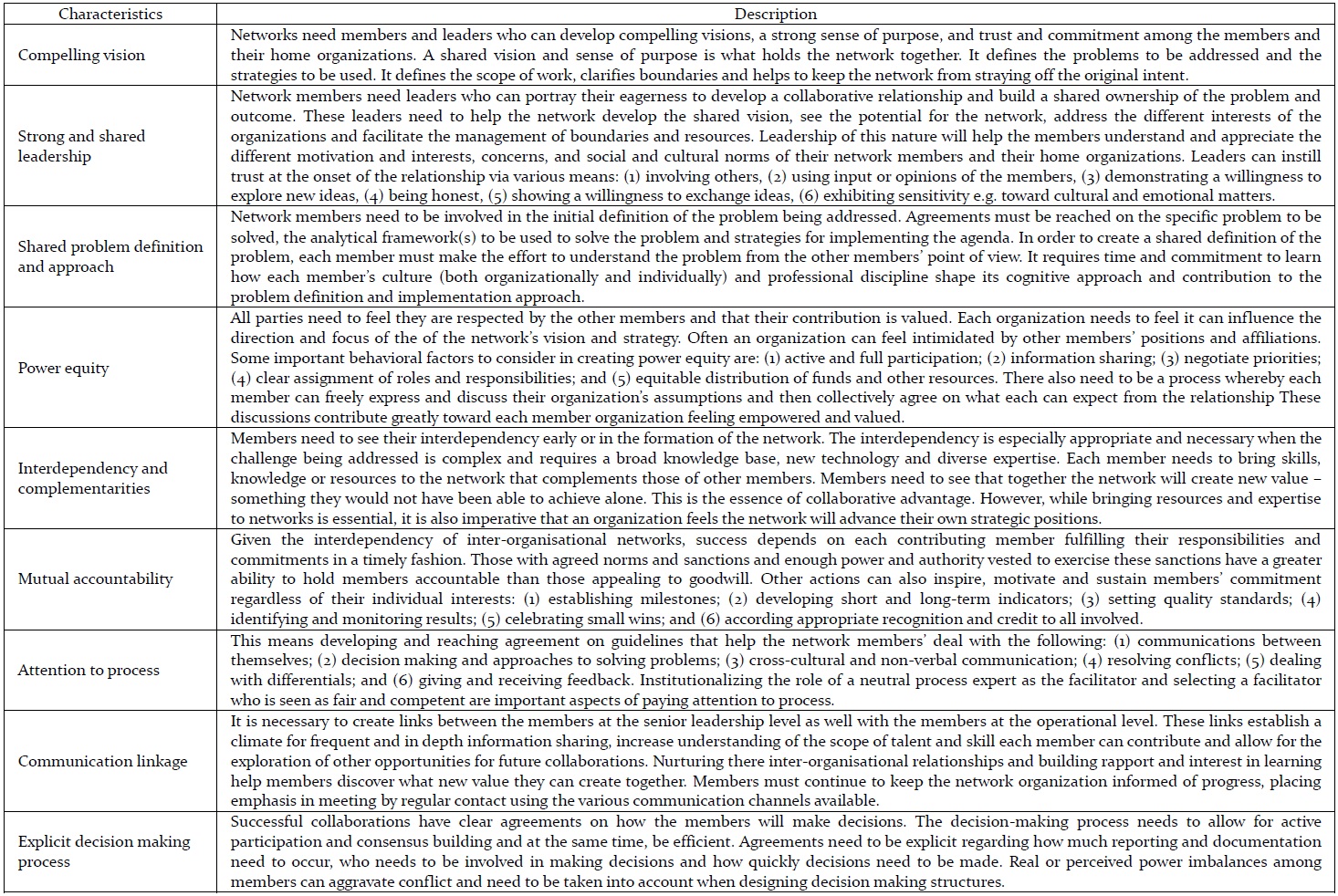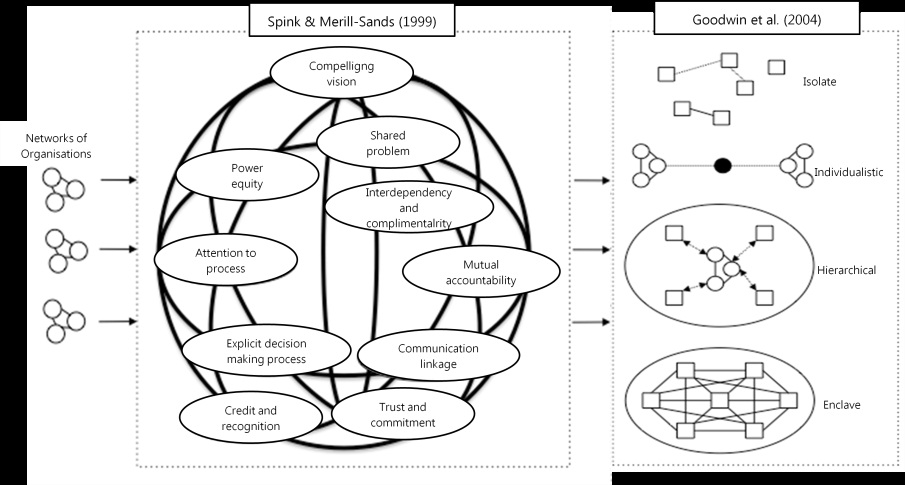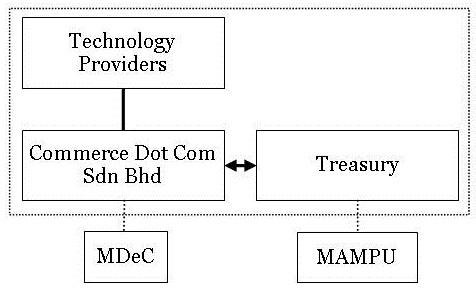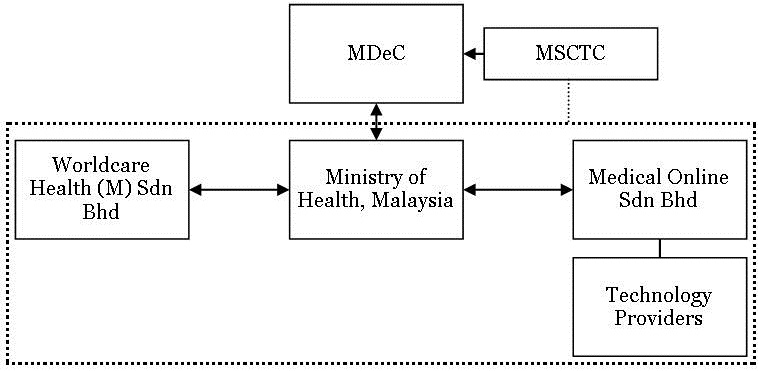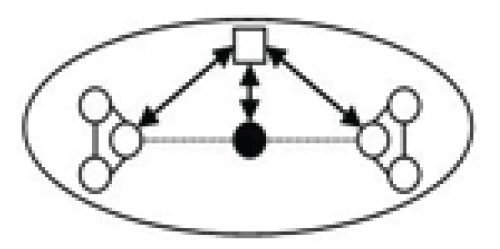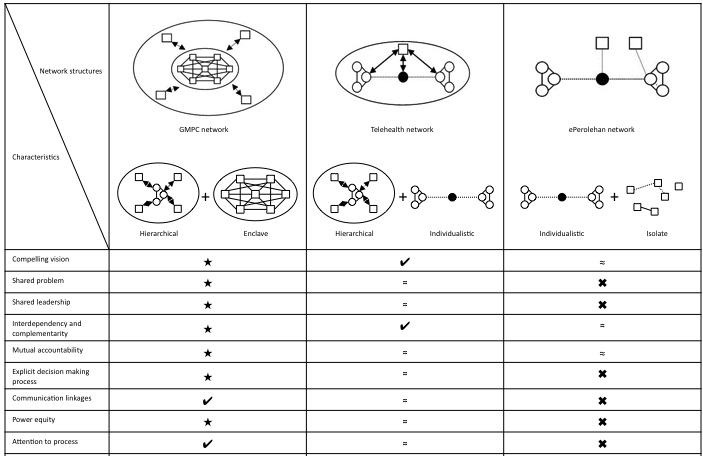



The mounting significance of inter-organisational networks for innovation necessitates the need for understanding their structures. In emerging economies, these networks are being formed through policy interventions. This paper presents some findings from an investigation of network structures between the organisations in different consortia set up by the Government of Malaysia as part of the Multimedia Super Corridor (MSC Malaysia) initiative.
MSC Malaysia is an initiative by the Government of Malaysia to create an multimedia environment in which an information and communication technology (ICT) industry and society can thrive. A policy-driven inter-organisational network approach represents the catalyst in Malaysia’s shift to a knowledge economy. MSC Malaysia provides for networks of organisations created through policy-driven cooperative arrangements, or “flagships” to enable the organisations to be innovative.
In today’s economy, understanding the benefits of inter-organisational networks becomes more essential than ever. This paper addresses the issue of structures that emerge in policy-driven inter-organisational networks in steering organisations to be innovative – in this case, the networks being the flagship projects of MSC Malaysia initiative. In the next section, the context of the study is outlined, proceeded by some background literature that provides the basis for the study. A section on the methodology follows with a subsequent description of the cases and their corresponding network participants. The findings related to their network structures and characteristics are then presented. A set of conclusions makes for the final closing.
In 1996, the MSC Malaysia was launched for Vision 2020.
In addition, the flagship applications enable MSC Malaysia
III. Some Related Literature on Inter-Organisational Networks, Structures and Innovation
In this section, selected pertinent literature is directed towards understanding key issues of inter-organisational networks for innovation and their corresponding structures and characteristics. Subsequently, this provides for the formation of this study’s framework. Aspects of inter-organisational networks and innovation are discussed first, followed by a discussion of network structures and characteristics.
1. Inter-Organisational Networks and Innovation
Innovation is largely seen as the fundamental indicator for firm performance (Mone, McKinley and Barker, 1998). It all began in the late 1920s when Schumpeter outlined innovation within the context of the organisation to be that of its new outputs, be it, according to Crossan and Apaydin (2010) in the form of a good, a production method, a market, a supply source or an organisational structure. Innovation is suggested to involve
At the same time, innovation can also be seen as a process where people socially connect with ideas and resources to create
In which case, it brings the discussion to the matter of networks and their significance to innovation. Much research on inter-organisational networks has been done (Provan, 1984; Hamel, 1991, Hagedoorn, 1993; Powell, Koput and Smith-Doerr, 1996; Dyer and Singh, 1998; Gulati and Garguilo, 1999; De Wever, Martens and Vandenbempt, 2001; Schilling and Phelps, 2007 etc.). They indicate that organisations develop inter-organisational relationships to acquire, create and use skills and knowledge for innovation. Sydow and Windeler (1998) describe an inter-organisational network as
Research studies on innovation point to the use of networks.
2. Understanding Network Structures for Innovation
Understanding network structures is important for innovation as network structures enable for the activity of information flow, exchange of ideas, learning, access to resources etc. According to Walter, Kogut and Shan (1997:110), network structure
Schibany, Hämäläinen and Schienstock (2001:10) look at network structures to comprise of (1) vertical and horizontal, (2) geographical scope, (3) organisational structure, (4) duration (as per achievement of objectives), (5) boundary (to the degree of openness and closeness), (6) architecture and balance of power, and (7) stability and trust (as per nature of membership). Todeva and Knoke (2005:124) identify network structures in the simpler context of inter-organisational relations i.e. hierarchical relations, joint ventures, equity investments, cooperatives, R&D consortia, cartels, franchising, licensing, subcontractor networks, industry standard groups, action sets and market relations.
According to Grandori and Soda (1995:199), there are three main categories of networks, in the context of coordination mechanisms employed and the degree of centralisation and formalisation: (1) social networks, (2) bureaucratic networks and (3) proprietary networks. Leoncini, Montresor and Vertova (2003:14) identify three network approaches under the context of cluster-oriented conditions for collaborations: (1) the industrial district, (2) the innovation milieu and (3) the regional system of innovation.
In a different context, Ahuja (2000) argues for dense network structures for innovation where network structures become more cohesive over time as individuals enhance existing connections among each other. On the other hand, Walker, Kogut and Shan (1997) debate on open network structures for innovation i.e. network structures that are continuously reshaped as individuals seek other new connections while focusing less on their earlier established connections. Burt (2004) adds on by saying that open network structures are the tool to bridge
2.1 Network Structures and Their Characteristics
Barnes (1954) introduces the concept of
The 4 generic structural types discussed by Goodwin et al. (2004:4) describe networks as
[Table 1] Network structure descriptions
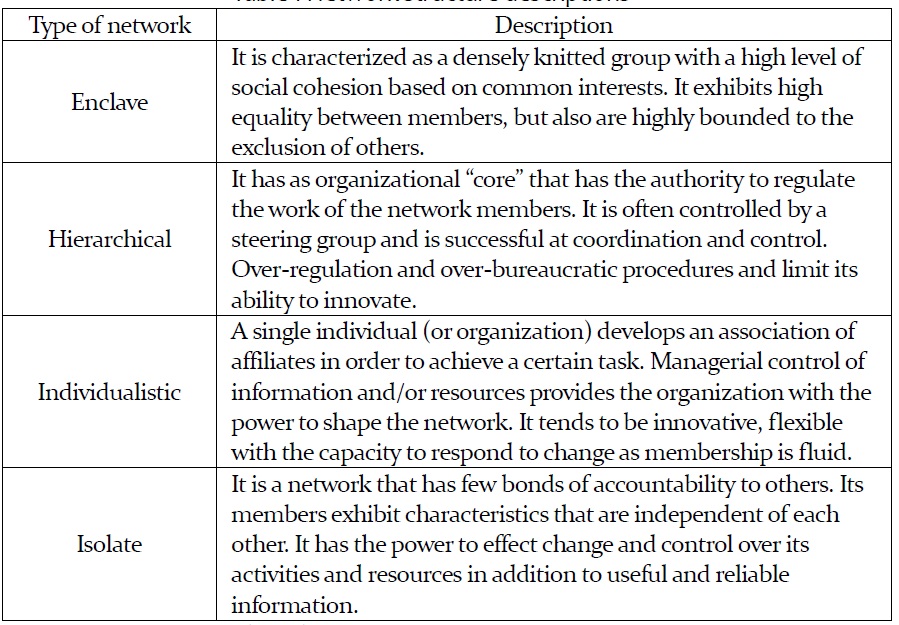
Network structure descriptions
In the context of network density, it would insinuate that dense network structures favour connectedness, where connectedness or “social integration” implies ties that
To further understand the characteristic patterns of relationships that a network can possess, focus can be directed to Spink and Merrill-Sands (1999) where they identify specific elements that ensure a strong foundation is developed among organisations in collaboration: (1) compelling vision, (2) shared problem definition and approach, (3) power equity, (4) interdependency and complementarity, (5) mutual accountability, (6) attention to process, (7) communication linkages, (8) explicit decision-making process, (9) trust and commitment, and (10) credit and recognition. Spink and Merrill-Sands (1999) place emphasis on the interdependence of these elements to the extent that the successful implementation of the elements will lead to
3. Policy-Driven Inter-Organisational Networks as Context
Inter-organisational networks can often significantly be inter-institutional in nature, as they involve more than just firms.
The background literature provides for several aspects that can be investigated to understand the structures of inter-organisational networks. There are studies about different conditions that influence the formation of networks, issues related to power, communication, equity, etc. But these studies are among organisations that have a structure - there seem to be minimal studies in the context of inter-organisational networks formed by policy, as with no predetermined structures available for investigating issues. Given these issues, network of Goodwin et al. (2004) structures in combination with Spink and Merrill-Sands’ (1999) characteristics allows for an appropriate framework to investigate the network structures that emerge in the MSC flagship consortia (see Figure 4).
The research setting chosen, viz. the MSC flagship consortia, involved a highly dynamic environment and warranted for such a design that entailed an exploratory approach; hence the research design was based on case study methodology. The study was guided by
Both secondary data and primary data have been used to collect the information for developing the cases. Primary data was collected from interviews of selected respondents, recorded and conducted via face to face. The interviews went on between 30 and 150 minutes. The interviews for the case studies were conducted between July 2005 and December 2006. The primary researcher had the sole responsibility over the data collection. The selection of interviewees was founded based on that they were key employees working in organisations that were the selected MSC Malaysia interorganisational flagship networks.
Four classes of respondents, totalling to 40 individuals, i.e. top management, managers, operational personnel and external parties (e.g. consultants, financiers, advisers, etc.) made up the study. There were 17 respondents from the GMPC network, 11 from ePerolehan and 12 from Telehealth.
The top management individuals had been involved in all aspects of the business; hence, the assumption that they possessed the necessary information of their organisations’ strategy and administration. The other respondents shed light on the dynamics and administration aspects of their respective flagship networks.
The cases were analysed independently. Each network participant was an individual case study, in which evidence were derived and correlated to draw out conclusions. Distinctive behavioural patterns of each case study were drawn up using field notes and transcribed interviews. Similar patterns and conclusions were sought out in the other case studies for instances of duplication. Subsequent analysis included looking for cross-case patterns, which, in this case, among the network organisations serving the same network, and also across all networks.
As mentioned earlier, network structures of Goodwin et al. (2004) were used to map out the different inter-organisational networks in the three MSC flagship consortia and the network characteristics of Spink and Merrill-Sands (1999) to understand their dynamics. With that, a description of the MSC interorganisational flagship consortia selected for study now follows in the next section.
V. Cases Selected from MSC Flagship Networks
The selected three MSC inter-organisational flagship consortia were the Government Multi Purpose Card (GMPC) Application (under the Smart Card Flagship), the Telehealth Application (under the Telehealth Flagship) and the Electronic Procurement (ePerolehan) Application (under the eGovernment Flagship). These three networks were selected due to public interest – where one was considered successful, the next fraught by setbacks and the third a failure.
The Government Multi Purpose Card (GMPC) network focused on the development of the MyKad – Malaysia’s national identification card. It possesses a embedded computer chip that enables applications like data processing and storage, and file management.
In May 1999, a group of organisations was awarded the contract to develop and deploy the smart card by the Malaysian. GMPC Corporation Sdn. Bhd., or the GMPC Consortium, was subsequently created, made up of 5 national and international organisations: UNISYS MSC Sdn. Bhd, CSA MSC Sdn. Bhd., EPNCR (M) Sdn. Bhd., IRIS Technologies Sdn. Bhd. and Dibena Enterprise Sdn. Bhd.
The Electronic Government (eGovernment) MSC Flagship Application, launched by the Government of Malaysia, was aimed at employing multimedia technologies as mean to improve the way the Government worked. Government procurement activities were to be streamlined along with the improvement in the quality of service under the flagship’s electronic procurement, or ePerolehan, project. Traditional manual procurement processes were to become electronic procurement processes on the Internet.
In 1999, Commerce Dot Com Sdn. Bhd became the appointed ePeolehan vendor. The Malaysian Administrative and Management Planning Unit (MAMPU) was the flagship lead agency and the ePerolehan Unit, under Treasury, became the lead implementing agency. MDeC was the monitoring agency.
The Telehealth flagship was launched in 1997. The lead agency for the Telehealth flagship had been the Ministry of Health (MOH).
The first two were to be essentially informational and educational services respectively targeted at the general public and the healthcare community, with major advancements anticipated in terms of services/information delivery system technology. The LHP was meant to keep a person’s comprehensive medical records in databases. Teleconsultation was to cover multimedia connectivity between healthcare service providers with the objective of enhancing and extending basic work processes.
The Telehealth project commenced for open tender in early 1998. Three of the applications, namely the MCPHIE, the CME and the LHP had been awarded to one organisation – Medical Online Sdn. Bhd – which has since gone into receivership due to problems incurred while on the project. The fourth application – Teleconsultation – was awarded to Worldcare Health (M) Sdn. Bhd. MSCTC, as it had been with the GMPC network, was the appointed government consultant, with MDeC as the monitoring agency. The Ministry of Health was the lead implementing agency for the flagship.
In summary, the three consortia were formed through invitation or by the efforts of the government. On one hand, it can be understood that the dynamics involved could be different given that different products/services had been involved but, on the other hand, superficially, without an investigation, all three consortia appeared to be similar in terms of the organisations involved and the goals to deliver certain objectives. Each consortium involved some (local and foreign) business organisations, government departments and a cluster development agency. Interestingly, at the time of the investigation, press reports regarding each of the consortia had been very different.
The GMPC consortium seemed to be very successful with the product ready for market, while ePerolehan was not doing too well and Telehealth has several negative reports. The following section provides an understanding of the structural issues based on information gained from the interviews using this study’s research framework.
VI. Findings from Three Selected MSC Flagship Networks
The analyses of the three MSC flagship networks revealed a mixture of Goodwin et al’s (2004) types of networks – more concisely, hybrids across the enclave, hierarchical, individualistic and isolate dimensions reflecting the dynamics of the respective network environments. The following sections are findings from the three selected MSC flagship networks, where quotes from the transcribed interviews conducted have also been inserted for descriptive purposes.
1. GMPC Network Structure and Characteristics
The GMPC network exhibited a even-handed enclave and hierarchical hybrid (see Figure 6). It depicted a “hierarchical” network in a wider context, indicated by the strong presence of the core government team and MDeC steering the GMPC consortium with singular emphasis given by the Director- General of the NRD, the lead implementing agency. The GMPC consortium also displayed certain characteristics resembling that of the “enclave” network in an inner context i.e. a densely knitted group with high equality among members. An indicator of this was the 20 percent equity held by the consortium members. At the same time, it was perceived that there were two nodal firms in the consortium i.e. Dibena as the appointed chair organisation and UNISYS as the project manager.
An enclave-hierarchical hybrid like the GMPC network, as the interviews indicated, was likely to display a clear understanding of its objective motivated by shared leadership and a common goal -
A Project Management Office was likely to enable the development of standard operating procedures and a decision-making process to be complied by the organisations -
This was a network that presumed a structure that motivated interdependency and complementarity -
Overall, the network insinuated strong characteristics of compelling vision, a shared problem definition and approach, interdependency and complementarity, and decision-making and power equity while, notwithstanding, the other characteristics stood robust.
2. Telehealth Network Structure and Characteristics
The Telehealth network displayed a hierarchical and individualistic hybrid (see Figure 7). Individualistic networks when a single individual or organisation associates with others to do a certain task. Such networks can fail due to high transaction costs or conflict between agencies. This would describe the environment of the network organisations involved in the Telehealth project. The Ministry of Health represented the single organisation that developed an association of affiliates in Medical Online and Worldcare.
In addition, interviews indicated that the appointments of Medical Online and Worldcare Health had been emphasised by economic exchange, which meets definition of Goodwin et al. (2004) of individualistic networks. Since the project had been actively being facilitated by MDeC and led by the Ministry, this gave it a hierarchical dimension to the network. Indications pointed to the network being constrained by over-bureaucratic procedures and overregulation – indications highlighted by Goodwin et al. (2004:6) that
Hierarchical networks may be the archetype for integration but as indications revealed in the Telehealth network, they tend to be overbureaucratic and controlling at times. However, a regulatory mechanism can obviate sub-optimal outcomes, especially in policy-driven inter-organisational networks like the MSC flagship networks, by linking network priorities directly to the priorities of the network members and subsequently fortifying interdependency among them, as suggested by Goodwin et al. (2004). It must have the aptitude to persuade network members that participating in the network will reward their time and investment within it.
The Telehealth network, a hierarchical-individualistic hybrid, had compelling vision to begin with -
Communication channels were neither sufficiently robust nor distinct –
Overall, the network displayed adequate interdependency and complementarity but lacked strength in the other identified characteristics. Change management and more effective governance mechanisms should be given necessary focus instead.
3. ePerolehan Network Structure and Characteristics
The ePerolehan network offered an isolate and individualistic hybrid (see Figure 8). Individualistic networks are when a single individual or organisation associates with others to do a certain task. Procuring a 'network' of service providers through contract negotiation is an example of this. The network positions of the organisations involved in the ePerolehan initiative represented the only aspect that closely resembled an individualistic network.
Treasury, under the Ministry of Finance, via the ePerolehan Unit, represented the organisation, which developed an association with Commerce Dot Com, a service provider, to realise the ePerolehan project. Perceptions indicated that, while MDeC outwardly facilitated the project, the Government played a far more active role in contributing to the development of the project and represented the controlling member in the network.
Goodwin et al. (2004) describe isolates to be strong at regulation but weak at integration; they also tend to not be accountable to the other network members. This description resembles the ePerolehan network where the network members were aloof towards each other and possessed a minimal sense of network camaraderie.
An isolate-individualistic hybrid in the ePerolehan network, it initially displayed a lackadaisical attitude –
Ultimately, due to unnecessary competition and conflict between the network members, the capacity and motivation for joint innovative working was resisted, which resulted in insufficient trust and commitment. Nevertheless, such a network’s circumstances could be greatly improved if the Government and the network facilitator had been open to introducing aggressive change management tactics, improved contractual terms and conditions and more proficient communication channels. It is possible that an institutional mechanism can fail to preserve such a network structure and instead be relegated to an almost negligible role – a role which can effect better results if a mandate is strictly exercised to administer the network organisations based on mutual accountability. In such a network, the network members tend to not be sufficiently motivated by regulation and governance in their network – instead, according to Uzzi (1996), motivation is likely to come from the original reason of the exchange. Overall, in the ePerolehan network, characteristics of compelling vision and, interdependency and complementarity were prevalent. The other characteristics stood adequate.
Summarising, while the GMPC network displayed predictable characteristics in lieu of a stable network structure, the ePerolehan network only began to possess significantly positive characteristics after it overcame project obstacles. On the other hand, the Telehealth network had commenced operations impressively but deteriorated over time, resulting in a major restructuring of a bulk of the project deliverables and winding-up procedures for one major service provider. Figure 11 below illustrates the overall findings.
It is perceived that these were very difficult challenges to effective collaboration – because of strong interpersonal, leadership and management skills, a desired collaborative advantage can be unlikely to derive out of the collaborative relationship (Spink and Merrill-Sands, 1999). This follows that different networks function on different portfolios of network characteristics but on a common note, a foundation of the characteristics has to exist before a climate of joint innovative working can develop within the networks.
It is also perceived in this study that the network manager, despite being one and the same for the three selected flagship networks, played substantially different roles respective to the networks it served. For the GMPC network, the respondents highlighted the active role played by MDeC in managing the network. Respondents perceived that MDeC succeeded, as a network manager, in being committed to the network. In the ePerolehan network, respondents highlighted that the network manager lacked responsibility. Respondents observed that the network gradually discounted MDeC over time. As for the Telehealth network, respondents highlighted about how
The analyses of the three MSC flagship networks revealed a hybrid of Goodwin et al’s (2004) networks – combinations of the enclave, hierarchical, individualistic and isolate forms resulting from their respective network dynamics. The GMPC network exhibited the enclave-hierarchical hybrid, the Telehealth network a hierarchical-individualistic hybrid and the ePerolehan network an isolate-individualistic hybrid.
The most significant discovery had been that network types only began to take shape after the organisations became accustomed to their roles in their respective networks. This had been evident in the three flagship networks. This was perceived to be the reason why the networks initially found it difficult to synchronise the availability of human and material resources with the requirements of the networks’ various tasks. Acknowledging the network type can lead to defining a better network structure for organisations to leverage on. An illustration of the networks in Figure 11 denotes the difference among the three MSC Malaysia networks.
Different networks exhibit different characteristics. In addition, the study offers evidence that networks need to be managed to ensure that prime results can be achieved and it is especially significant for policy-driven networks where national initiatives and policies are imperative. This brings to mind the role of a network manager. Such an individual (or organisation) will be able to administer the social organisation of the network. It is suggested that the network manager will be the one to put into place the foundation elements necessary for a network to develop the characteristics towards creating an environment that is conducive for the network members to learn and benefit. Thus, both the network manager and the network (including its members) must be committed to the norms of cooperation and must work towards accomplishing network and organisational goals (Human and Provan, 1997).
As a final word, from literature’s point of view, the paper provides an application of a framework that combines network structures of Goodwin et al. (2004) with Spink and Merrill-Sands’ (1999) characteristics that can be useful to identify and analyse the types of network structures that emerge in interorganisational projects. The paper has the obvious limitations of the case study methodology. The paper is based on three cases, all from the MSC Malaysia initiative and related to the Information and Communication Technology (ICT) cluster. Nonetheless, the findings from these cases can be seen as indicative and are hoped to provide lessons for other emerging countries that are embarking on similar projects i.e. cluster-oriented developments with policydriven inter-organisational networks. These findings are seen as particularly useful when emerging countries invest in technology-related projects and invite multinational companies to work together with local firms.

